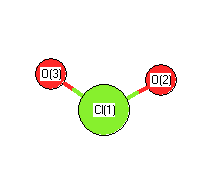.
| squib |
reference |
DOI |
| 1966Herzberg |
Herzberg, G., Electronic spectra and electronic structure of polyatomic molecules,Van Nostrand,New York, 1966 |
|
| 1979HUB/HER |
Huber, K.P.; Herzberg, G., Molecular Spectra and Molecular Structure. IV. Constants of Diatomic Molecules, Van Nostrand Reinhold Co., 1979 |
10.1007/978-1-4757-0961-2 |
| 1983Tan/Tan:425 |
K Tanaka, T Tanaka "CO2 and N2O Laser Stark Spectroscopy of the nu1 Band of the ClO2 Radical" J. Mol. Spect. 98, 425-452, 1983 |
10.1016/0022-2852(83)90253-9 |
| 1992Kuchitsu(II/21) |
Kuchitsu (ed.), Landolt-Bornstein: Group II: Atomic and Molecular Physics Volume 21: Structure Data of Free Polyatomic Molecules. Springer-Verlag, Berlin, 1992. |
|
| 2002Rie/Tsc:231 |
JC Rienstra-Kiracofe, GS Tschumper, HF Schaefer III, S Nandi, GB Ellison "Atomic and Molecular Electron Affinities: Photoelectron Experiments and Theoretical Computations" Chemical Reviews 2002, 102, 231-282 |
10.1021/cr990044u |
| JANAF |
Chase, M.W., Jr.; Davies, C.A.; Downey, J.R., Jr.; Frurip, D.J.; McDonald, R.A.; Syverud, A.N., JANAF Thermochemical Tables (Third Edition), J. Phys. Chem. Ref. Data,Suppl. 1, 1985, 14, 1. |
|
| VEEL5 |
M.E. Jacox, Vibrational and Electronic Energy Levels of Polyatomic Transient Molecules, J. Phys. Chem.Ref. Data, Monograph 3 (1994) (updated data in NIST Chemistry Webbook - http://webbook.nist.gov/chemistry/ |
|
| webbook |
NIST Chemistry Webbook (http://webbook.nist.gov/chemistry) |
10.18434/T4D303 |











